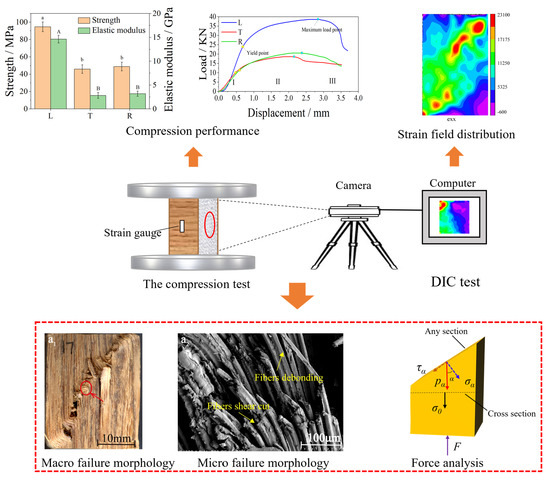Compressive Failure Mechanism of Structural Bamboo Scrimber
Abstract
:1. Introduction
2. Materials and Methods
2.1. Materials
2.2. Test Methods
2.3. Microscopic Fracture Morphology
3. Results and Discussion
3.1. Compression Performance
3.2. Macroscopic Failure Morphology
3.3. Microscopic Failure Morphology
3.4. Failure Mechanism
3.4.1. Force Analysis
3.4.2. Strain Field Distribution
4. Conclusions
- (1)
- The compressive load–displacement curves of bamboo scrimber in longitudinal, tangential and radial directions all contained an elastic, yield and failure stage.
- (2)
- The compressive strength of bamboo scrimber along the longitudinal direction was 94.67 MPa, which was 2.06 times that of the tangential specimens and 1.94 times that of the radial specimens. The elastic modulus of the longitudinal specimens was 14.61 GPa, which was 5.20 times that of the tangential specimens and 4.59 times that of the radial specimens.
- (3)
- The micro-failure morphology shows that the parenchyma cells showed brittle shear failure in all three directions, and the fiber failure of the longitudinal compressive specimens was ductile fracture, while that of the tangential and radial compressive specimens was brittle fracture. This is one of the reasons that the deformation of the specimens under longitudinal compression was greater than in the tangential and radial directions.
- (4)
- Under the compression of three grain directions, the macro-failure modes of bamboo scrimber include five modes, which are the “Y” crack (mode I), diagonal crack at 60° (mode II), diagonal crack at 45° (mode III), vertical crack (mode IV) and mixed crack (mode V). Among these, the longitudinal specimens include the modes I, II, III, and IV, the tangential specimens include the modes I, II, III, IV, and V, and the radial specimens include the modes I, II, IV, and V. The main failure mode of the longitudinal and radial compressive specimens was shear failure, while that of the tangential compressive specimens was interlayer separation failure. The reason for the difference was that the maximum strain occurred at the diagonal of the specimen during longitudinal and radial compression, while the maximum strain occurred at the bonding interface under tangential compression.
- (5)
- Bamboo scrimber is a new kind of structural engineering material with broad application prospects. There has been little research on the bonding interface performance, long-term performance and seismic performance of bamboo scrimber when used as a structural material, something to which more attention needs to be paid.
Author Contributions
Funding
Data Availability Statement
Acknowledgments
Conflicts of Interest
References
- Liese, W. Research on bamboo. Wood Sci. Technol. 1987, 21, 189–209. [Google Scholar] [CrossRef]
- Scurlock, J.; Dayton, D.; Hames, B. Bamboo: An overlooked biomass resource? Biomass Bioenergy 2000, 19, 229–244. [Google Scholar] [CrossRef] [Green Version]
- Elejoste, A.; Arevalillo, A.; Gabilondo, N.; Butron, A.; Peña-Rodriguez, C. Morphological Analysis of Several Bamboo Species with Potential Structural Applications. Polymers 2021, 13, 2126. [Google Scholar] [CrossRef]
- Sun, Y.; Zhang, Y.; Huang, Y.; Wei, X.; Yu, W. Influence of Board Density on the Physical and Mechanical Properties of Bamboo Oriented Strand Lumber. Forests 2020, 11, 567. [Google Scholar] [CrossRef]
- Mahdavi, M.; Clouston, P.L.; Arwade, S.R. A low-technology approach toward fabrication of Laminated Bamboo Lumber. Constr. Build. Mater. 2012, 29, 257–262. [Google Scholar] [CrossRef]
- Wang, Y.-Y.; Peng, W.-J.; Chai, L.-Y.; Peng, B.; Min, X.-B.; He, D.-W. Preparation of adhesive for bamboo plywood using concentrated papermaking black liquor directly. J. Cent. South Univ. Technol. 2006, 13, 53–57. [Google Scholar] [CrossRef]
- Huang, Y.; Ji, Y.; Yu, W. Development of bamboo scrimber: A literature review. J. Wood Sci. 2019, 65, 25. [Google Scholar] [CrossRef]
- Li, H.-T.; Chen, G.; Zhang, Q.; Ashraf, M.; Xu, B.; Li, Y. Mechanical properties of laminated bamboo lumber column under radial eccentric compression. Constr. Build. Mater. 2016, 121, 644–652. [Google Scholar] [CrossRef]
- Li, H.; Qiu, Z.; Wu, G.; Wei, D.; Lorenzo, R.; Yuan, C.; Zhang, H.; Liu, R. Compression Behaviors of Parallel Bamboo Strand Lumber Under Static Loading. J. Renew. Mater. 2019, 7, 583–600. [Google Scholar] [CrossRef] [Green Version]
- Sheng, B.; Zhou, A.; Huang, D. Stress-strain relationship of parallel strand bamboo under uniaxial or pure shear load. J. Civ. Archit. Environ. Eng. 2015, 37, 24–31. [Google Scholar] [CrossRef]
- Deng, C.; Zhang, H.; Yin, J.; Xiong, X.; Wang, P.; Sun, M.; Li, W.Q. Compression performance and failure mechanism of C/C-Cu composites. Chin. J. Mater. Res. 2017, 31, 182–186. [Google Scholar] [CrossRef]
- Liu, H.; Jiang, Z.; Fei, B.; Hse, C.; Sun, Z. Tensile behaviour and fracture mechanism of moso bamboo (Phyllostachys pubescens). Holzforschung 2015, 69, 47–52. [Google Scholar] [CrossRef]
- Habibi, M.K.; Lu, Y. Crack Propagation in Bamboo’s Hierarchical Cellular Structure. Sci. Rep. 2014, 4, srep05598. [Google Scholar] [CrossRef] [Green Version]
- Zhou, W.; Zhang, R.; Fang, D. Design and analysis of the porous ZrO2/(ZrO2+Ni) ceramic joint with load bearing–heat insulation integration. Ceram. Int. 2016, 42, 1416–1424. [Google Scholar] [CrossRef] [Green Version]
- Navaratnam, S.; Ngo, T.; Christopher, P.; Linforth, S. The use of digital image correlation for identifying failure characteristics of cross-laminated timber under transverse loading. Measurement 2020, 154, 107502. [Google Scholar] [CrossRef]
- Wang, D.; Lin, L.; Fu, F. Fracture mechanisms of moso bamboo (Phyllostachys pubescens) under longitudinal tensile loading. Ind. Crop. Prod. 2020, 153, 112574. [Google Scholar] [CrossRef]
- Bakir, K.; Aydemir, D.; Bardak, T. Dimensional stability and deformation analysis under mechanical loading of recycled PET-wood laminated composites with digital image correlation. J. Clean. Prod. 2021, 280, 124472. [Google Scholar] [CrossRef]
- Krause, J.Q.; Silva, F.d.A.; Ghavami, K.; Gomes, O.d.F.M.; Filho, R.D.T. On the influence of Dendrocalamus giganteus bamboo microstructure on its mechanical behavior. Constr. Build. Mater. 2016, 127, 199–209. [Google Scholar] [CrossRef]
- Standard Administration of China. Method of Testing Compressive Strength Parallel to Grain of Wood; GB/T 1935-2009; Standard Administration of China: Beijing, China, 2009; pp. 1–2. [Google Scholar]
- Standard Administration of China. Method for Determination of the Modulus of Elasticity in Compression Parallel to Grain of Wood; GB/T 15777-2017; Standard Administration of China: Beijing, China, 2009; pp. 1–4. [Google Scholar]
- Dixon, P.G.; Gibson, L.J. The structure and mechanics of Moso bamboo material. J. R. Soc. Interface 2014, 11, 20140321. [Google Scholar] [CrossRef] [PubMed]
- Zhang, Y.; Huang, X.; Yu, Y.; Yu, W. Effects of internal structure and chemical compositions on the hygroscopic property of bamboo fiber reinforced composites. Appl. Surf. Sci. 2019, 492, 936–943. [Google Scholar] [CrossRef]
- Yu, Y.; Liu, R.; Huang, Y.; Meng, F.; Yu, W. Preparation, physical, mechanical, and interfacial morphological properties of engineered bamboo scrimber. Constr. Build. Mater. 2017, 157, 1032–1039. [Google Scholar] [CrossRef]
- Liu, H.; Peng, G.; Chai, Y.; Huang, A.; Jiang, Z.; Zhang, X. Analysis of tension and bending fracture behavior in moso bamboo (Phyllostachys pubescens) using synchrotron radiation micro-computed tomography (SRμCT). Holzforschung 2019, 73, 1051–1058. [Google Scholar] [CrossRef]
- Chen, Q.; Dai, C.; Fang, C.; Chen, M.; Zhang, S.; Liu, R.; Liu, X.; Fei, B. Mode I interlaminar fracture toughness behavior and mechanisms of bamboo. Mater. Des. 2019, 183, 108132. [Google Scholar] [CrossRef]
- Li, H.; Zhang, H.; Qiu, Z.; Su, J.; Wei, D.; Lorenzo, R.; Yuan, C.; Liu, H.; Zhou, C. Mechanical Properties and Stress Strain Relationship Models for Bamboo Scrimber. J. Renew. Mater. 2020, 8, 13–27. [Google Scholar] [CrossRef]
- Cui, C.; Dong, J.; Mao, X. Effect of braiding angle on progressive failure and fracture mechanism of 3-D five-directional carbon/epoxy braided composites under impact compression. Compos. Struct. 2019, 229, 111412. [Google Scholar] [CrossRef]
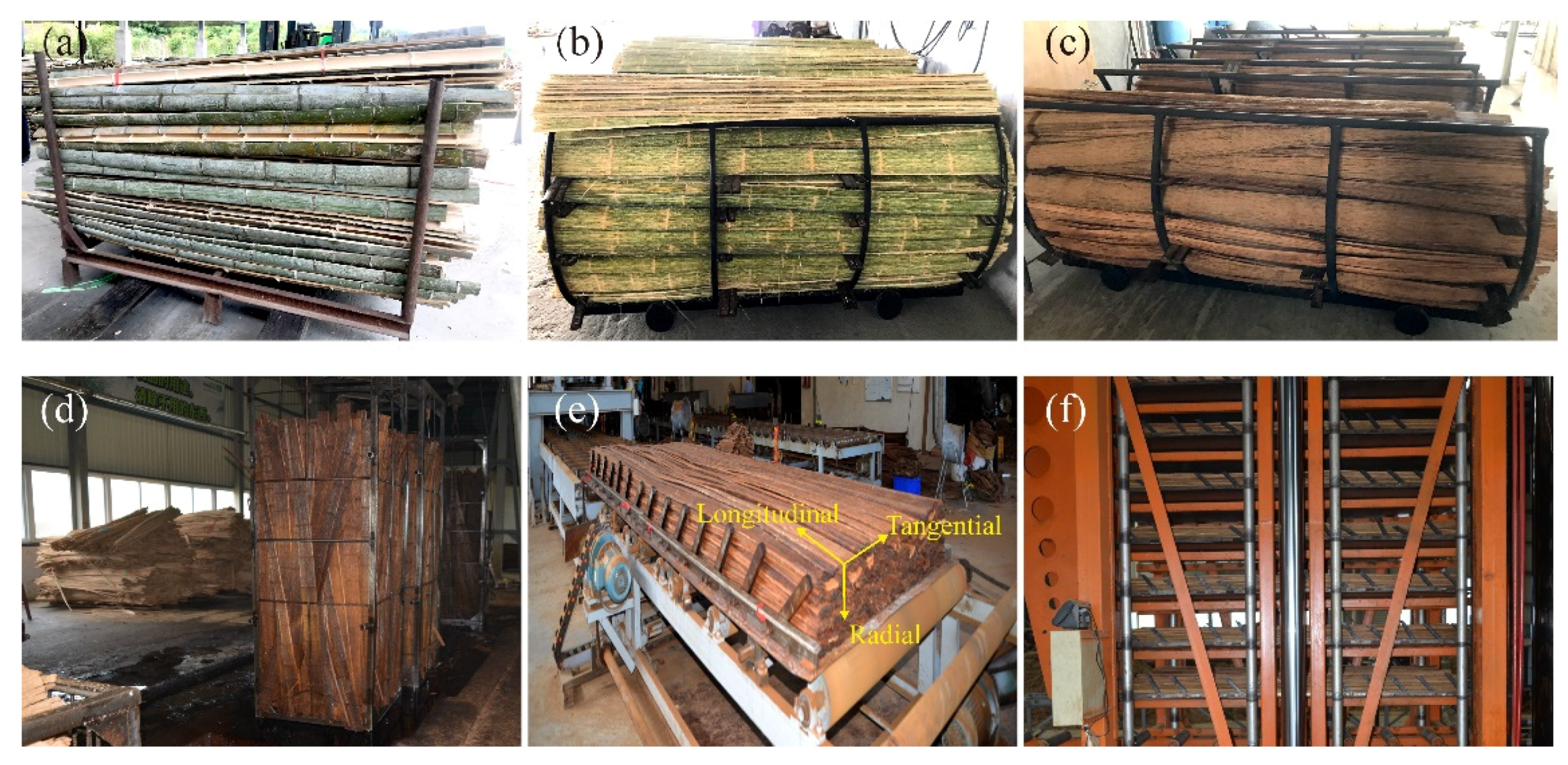



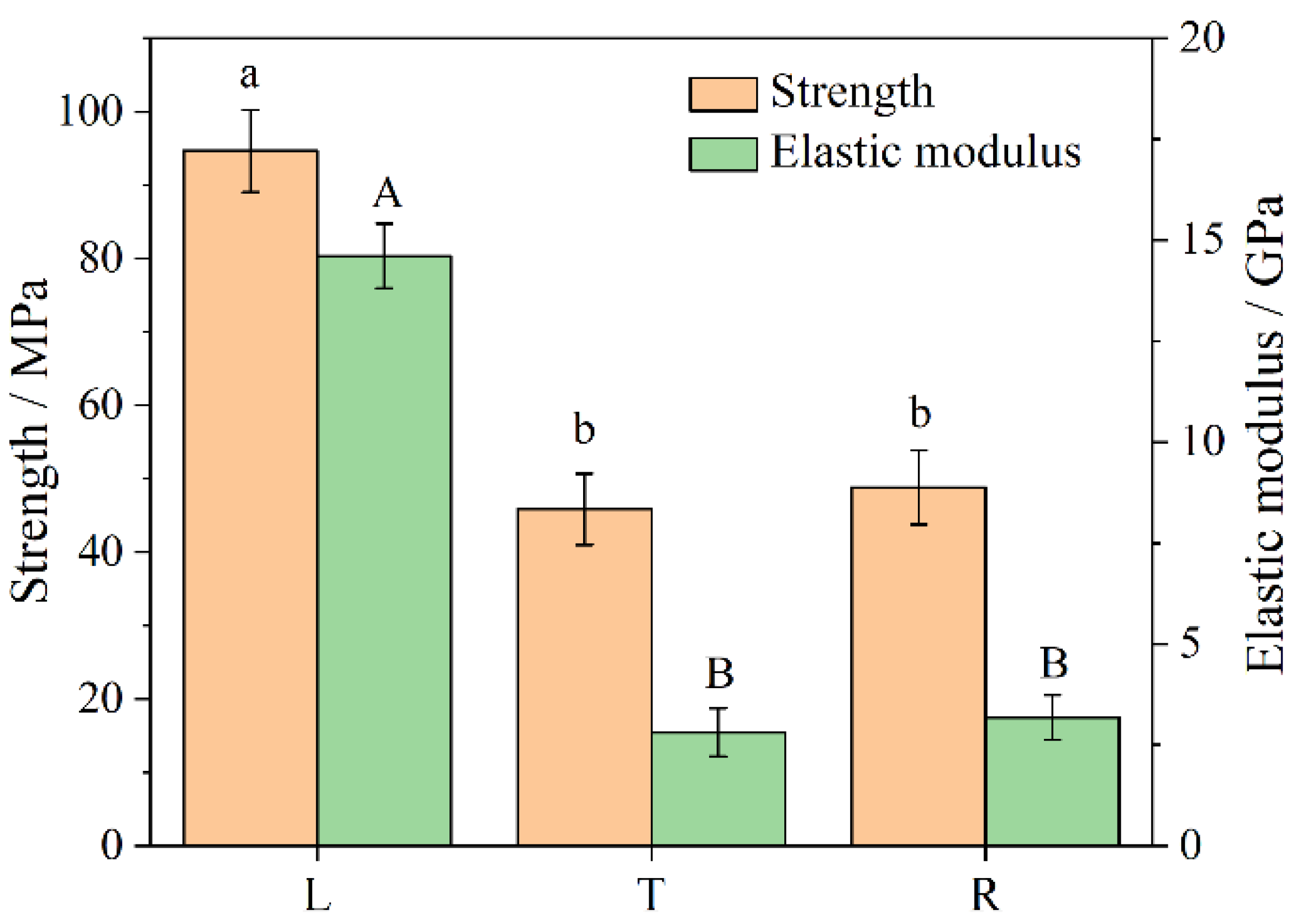
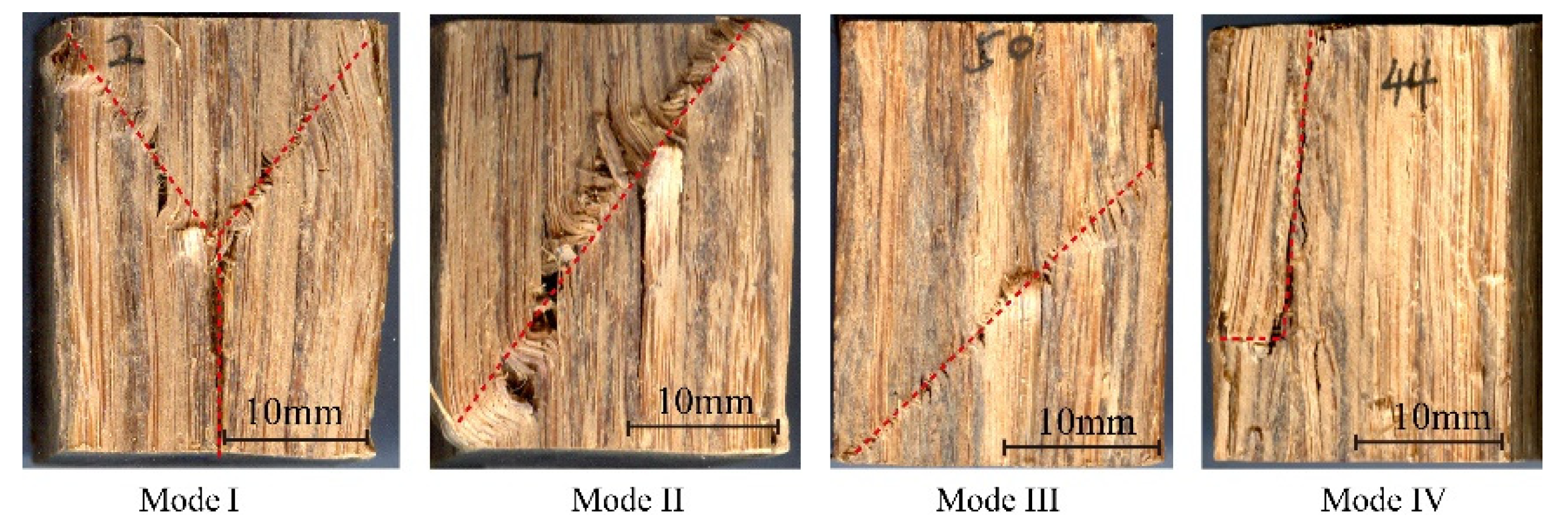

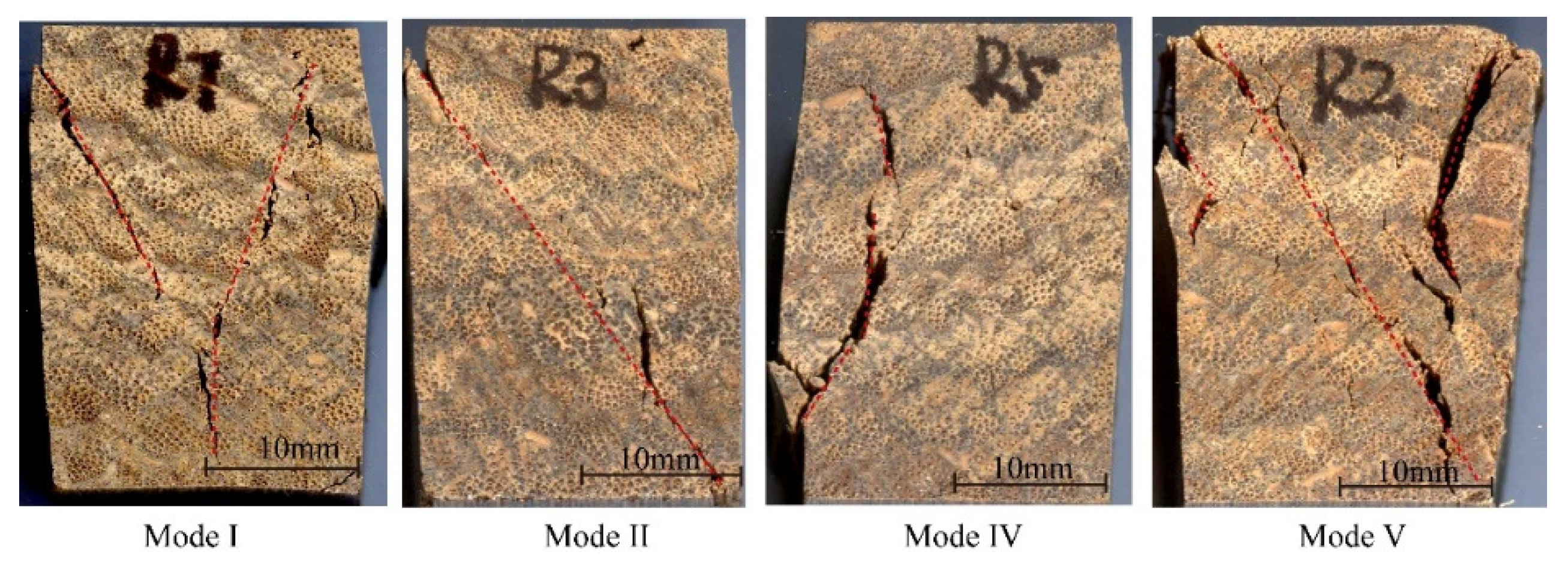
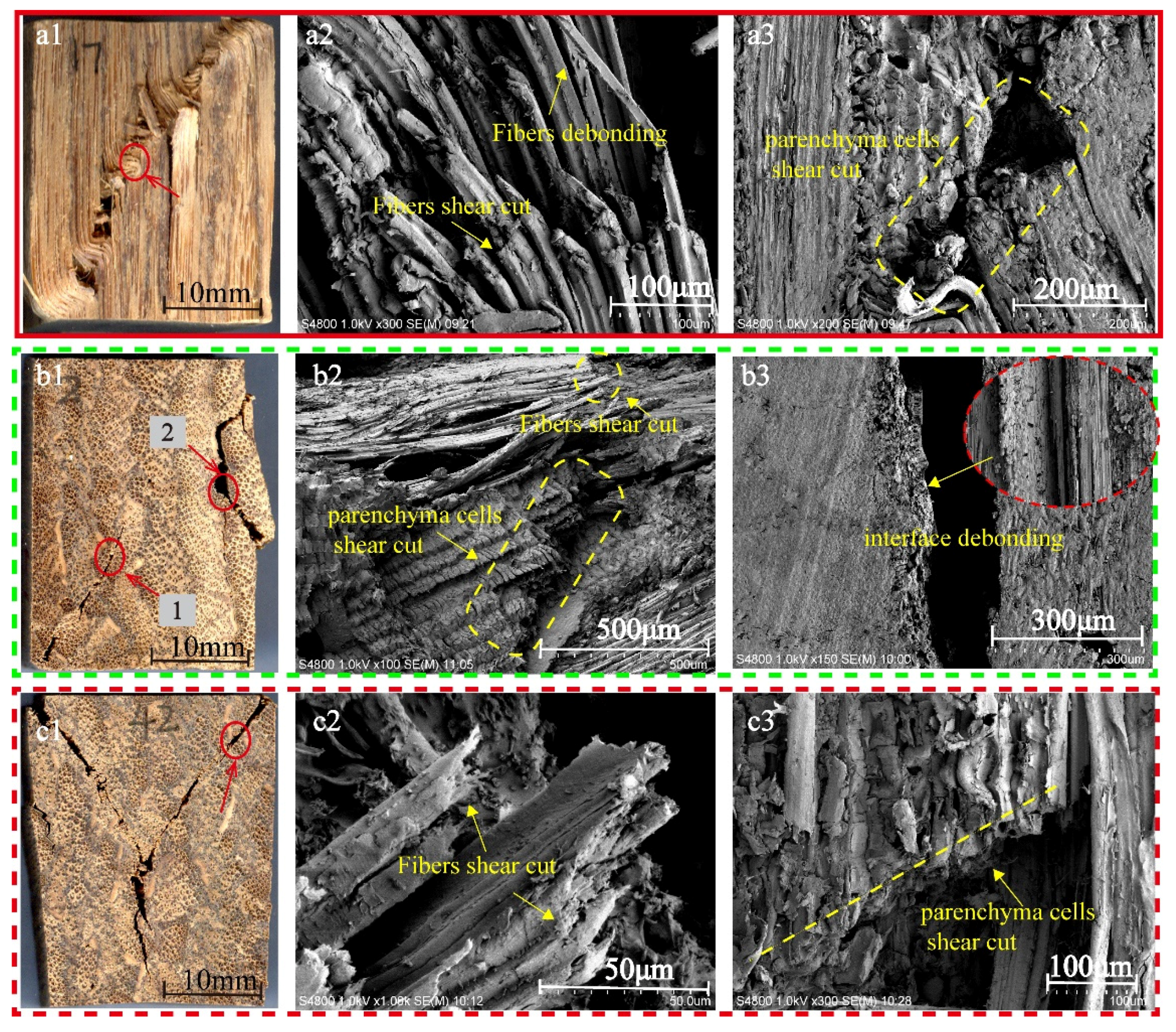
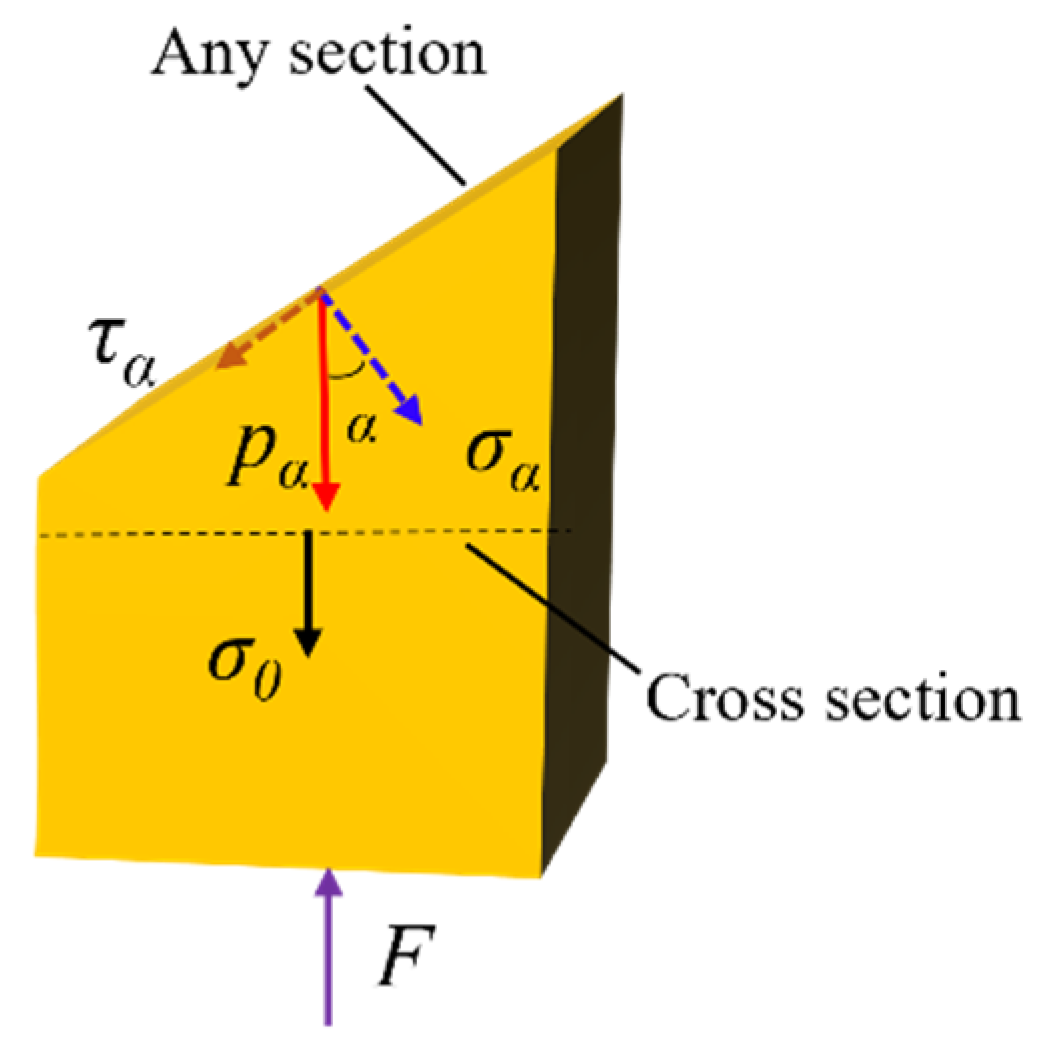

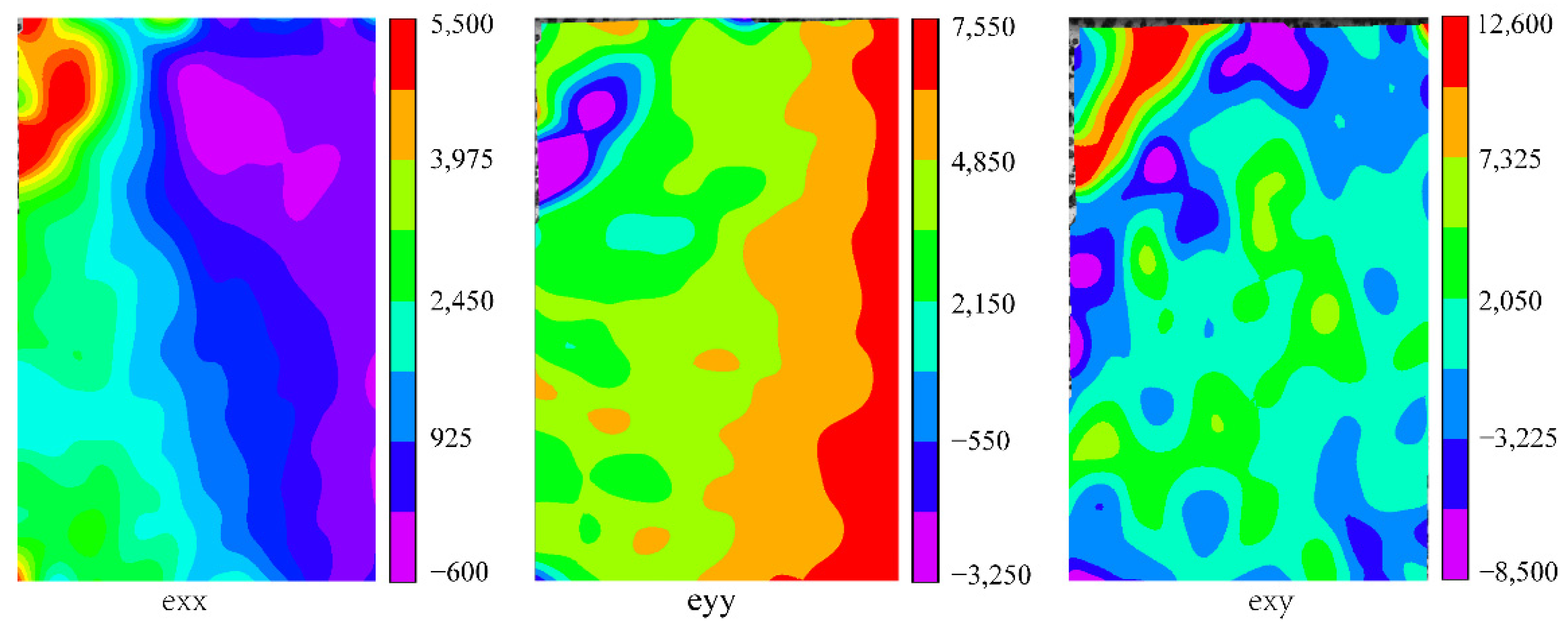
| Specimen Group | Mode I | Mode II | Mode III | Mode IV | Mode V | Total |
|---|---|---|---|---|---|---|
| L | 50% | 26% | 22% | 2% | - | 54 |
| T | 11% | 18% | 15% | 22% | 34% | 54 |
| R | 50% | 9% | - | 15% | 26% | 54 |
Publisher’s Note: MDPI stays neutral with regard to jurisdictional claims in published maps and institutional affiliations. |
© 2021 by the authors. Licensee MDPI, Basel, Switzerland. This article is an open access article distributed under the terms and conditions of the Creative Commons Attribution (CC BY) license (https://creativecommons.org/licenses/by/4.0/).
Share and Cite
Wang, X.; Zhong, Y.; Luo, X.; Ren, H. Compressive Failure Mechanism of Structural Bamboo Scrimber. Polymers 2021, 13, 4223. https://doi.org/10.3390/polym13234223
Wang X, Zhong Y, Luo X, Ren H. Compressive Failure Mechanism of Structural Bamboo Scrimber. Polymers. 2021; 13(23):4223. https://doi.org/10.3390/polym13234223
Chicago/Turabian StyleWang, Xueyu, Yong Zhong, Xiangya Luo, and Haiqing Ren. 2021. "Compressive Failure Mechanism of Structural Bamboo Scrimber" Polymers 13, no. 23: 4223. https://doi.org/10.3390/polym13234223
APA StyleWang, X., Zhong, Y., Luo, X., & Ren, H. (2021). Compressive Failure Mechanism of Structural Bamboo Scrimber. Polymers, 13(23), 4223. https://doi.org/10.3390/polym13234223




